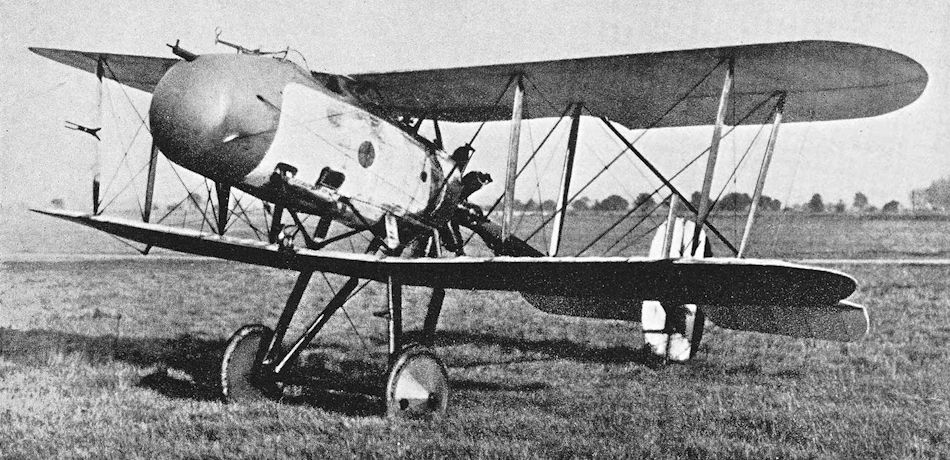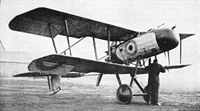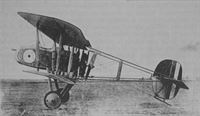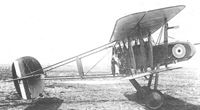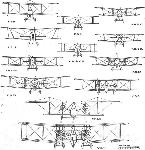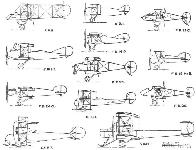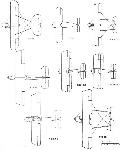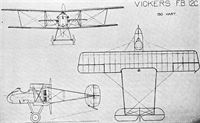C.Andrews Vickers Aircraft since 1908 (Putnam)
<...>
Also in the single-seat fighter class were the two Vickers pusher types, the F.B.12 and the F.B.26. Both had chequered careers. The F.B.12 was also intended for the 150 hp Hart static radial engine, but continual delays with this engine and the shortage of rotaries for experimental work led to the installation of an 80 hp Le Rhone taken from another aeroplane. The F.B.12 flew in June 1916, but, being underpowered, had a most disappointing performance. A 100 hp Gnome monosoupape was then substituted. Even in this guise, as the F.B.12A, it still had only two-thirds the designed power, and so lost any performance advantage it might have had (with the 150 hp promised from the Hart) over the D.H.2 and F.E.8 pusher fighters already in service, but it went to France in December 1916 for operational trials. The F.B.12B with the Hart engine was completed in February 1917, its wing span increased from 26 ft to 29 ft 9 in, but it crashed, thus helping to settle the fate of the Hart engine once and for all. A contract was placed with the Wells Aviation Company of Chelsea for the F.B.12C, and the few examples made were fitted with a variety of engines, including Gnome monosoupape, Le Rhone and the Anzani static radial, all nominally about 100 hp. The AID report on the first production example, A7351, was so critical, and disclosed a top speed of only 87 mph, that, coupled with the failure of the Hart, it could lead to nothing but a cancellation of the contract.
F.B.12C - One 150 hp Hart. Span 29 ft 9 in, upper, and 26 ft 9 in, lower; length 21 ft 10 in; height 8 ft 7 in; wing area 237 sq ft. Empty weight 927 lb; gross weight 1,447 lb. Max speed 87 mph at 6,500 ft; climb to 10,000 ft - 18 1/2 min; service ceiling 14,500 ft; absolute ceiling 15,000 ft; endurance 3 1/4 hr. Armament one Lewis gun mounted in nose of nacelle.
Показать полностью
P.Lewis The British Fighter since 1912 (Putnam)
Although by 1916 the tractor layout was firmly established as the optimum for most classes of aeroplane, Vickers pressed forward during the year with another single-seat pusher fighter - the F.B.12. A well-streamlined nacelle was carried between the two-bay wings, the whole machine being designed around the 150 h.p. Hart radial engine which was expected to endow the F.B.12 with a performance superior to that of other pusher fighters extant. The F.B. 12’s airframe was ready before any example of its intended engine so the 80 h.p. le Rhone served to flight-test the machine in June, 1916. As well as flying with the le Rhone engine, the F.B.12 flew with the more powerful 100 h.p. Monosoupape Gnome and tests were made with revised wings of larger size and more angular form. Armament in each version was a single Lewis gun set well back in the upper nose of the nacelle.
Yet another version of the basic F.B.12 design, the F.B.12C, made its appearance. The scheduled engine was again the elusive 150 h.p. Hart radial but, once more, it failed to materialize and in its place the F.B.12C utilized both the 110 h.p. le Rhone and the 100 h.p. Anzani. The machine differed from the two previous F.B.12 designs in having a flat-sided nacelle in place of the circular type, and modified wings and tail. Although Service Trials were carried out at the end of the year, the pusher fighter was in eclipse and could not be expected to compete with the cleaner tractor types.
Показать полностью
F.Mason The British Fighter since 1912 (Putnam)
Vickers F.B.12
Design of the F.B.12 was begun early in 1916 as an attempt to extend the Gunbus formula into the single-seat scout class, presumably to provide a replacement for the ‘first generation’ D.H.2s and F.E.8s. However, by the time it was flown in June that year, both the Sopwith Pup and Triplane had appeared and demonstrated a considerable advance in performance.
If in fact the engine originally intended for the F.B.12, the 150hp Hart nine-cylinder radial, had been available in time, the Vickers aircraft would probably have matched the Pup’s performance, but as it was not, an 80hp Le Rhone was substituted and bestowed a maximum speed of only 95 mph. When it first appeared the aircraft featured short wings with elliptical tips and a circular-section nacelle located in the centre of the wing gap. Armament comprised a single Lewis gun protruding from the upper part of the nose. In this form the engine was soon changed to a 100hp Gnome monosoupape and this increased the speed by about five miles per hour.
A production order was raised for 50 aircraft, including the prototype, and the design underwent much modification before the second example appeared. The wings were lengthened to feature square-raked tips and the nacelle was altered to near-rectangular section, the engine being changed once again, this time to a 100hp Le Rhone; these changes, one imagines, were introduced to facilitate production, but had increased the drag and the aircraft, now termed the F.B.12C, could still only manage about 100 mph, although the rate of climb was improved. Finally a 100hp Anzani engine was installed, but again without significant improvement.
With no advance in performance evident, the F.B.12C‘s production was halted after only seventeen aircraft had been completed. As far as is known, none entered operational service, although it is believed that the Gnome-powered prototype underwent trials in France in December 1916, and an F.B.12C flew with a Home Defence unit the following year.
Type: Single pusher engine, single-seat, two-bay biplane scout.
Manufacturer: Vickers Ltd (Aviation Department), Knightsbridge, London.
Powerplant: F.B.12. 80hp Le Rhone; 100hp Gnome monosoupape. F.B.12C. 110hp Le Rhone; 100hp Anzani.
Dimensions: F.B.12. Span, 26ft 0in; length, 21ft 6in; height, 8ft 7in; wing area, 204 sq ft. F.B.12C. Span, 29ft 9in; length, 21ft 10in; height, 8ft 7in; wing area, 237 sq ft.
Weights: F.B.12 (80hp Le Rhone). Tare, 845lb; all-up, 1,275lb. F.B.12C (100hp Le Rhone). Tare, 927lb; all-up, 1,400lb.
Performance: F.B.12 (80hp Le Rhone). Max speed, 95 mph at sea level; climb to 5,000ft, 9 min 50 sec; service ceiling, 11,500ft. F.B.12C (100hp Le Rhone). Max speed, 100 mph at sea level; climb to 5,000ft, 6 min 55 sec; service ceiling, 14,500ft.
Armament: One 0.303in Lewis machine gun in nose of nacelle.
Prototype: One F.B.12, A7351 (first flown, June 1916).
Production: F.B.12C. 17 aircraft completed (A7352-A7368).
Summary of Service: A7351 underwent trials in France in December 1916; and at least one aircraft flew with a Home Defence unit in 1917.
Показать полностью
W.Green, G.Swanborough The Complete Book of Fighters
VICKERS F.B.12 UK
A compact two-bay biplane of pusher type, the F.B.12 was designed for the 150 hp Hart static radial engine, in the development of which the Hart Engine Company was being assisted by Vickers. With a single-seat nacelle faired out to a circular cross section and mounted in mid wing-gap, and tailbooms converging in side elevation to meet at the rear spar of the tailplane. the F.B.12 had a basic structure primarily of steel tube. Unavailability of an airworthy Hart engine led to the first F.B.12 being fitted with an 80 hp Le Rhone rotary, with which it flew in June 1916. Although underpowered, it demonstrated a creditable performance when tested at the Central Flying School in the following August. The Le Rhone was then replaced by a 100 hp Gnome Monosoupape, and, subsequently, new wings of greater span were fitted - overall span being extended by 3 ft 7 in (1,09 m) - with straight raked rather than elliptical tips. Redesignated F.B.12A, this aircraft was sent to France for operational evaluation in December 1916. A further aircraft was built - by Wells Aviation of Chelsea - with the Hart engine as the F.B.12B. This was flown early in 1917, but promptly crashed, helping to seal the fate of the Hart radial. A contract for 50 aircraft powered by the Hart had, on 10 November 1916, been awarded Vickers, the intention being to fit the series aircraft with a new, wooden nacelle and enlarged vertical tail surfaces as the F.B.12C. Production of the F.B.12C was sub-contracted to Wells Aviation, but with the loss of the F.B.12B, the Hart engine was abandoned. In the event, only 18 F.B.12C airframes were completed and these were fitted with a variety of engines, including the 110 hp Le Rhone nine-cylinder rotary and the 100 hp Anzani 10-cylinder radial. Testing at Martlesham Heath in May 1917 revealed insufficient elevator control at low speeds, heavy lateral control and other problems. Furthermore, the gun (a 0.303-in/7,7-mm Lewis) was considered to be badly positioned for changing ammunition drums. By this time, tractor fighters of superior performance were in RFC service and further development of the F.B.12 was therefore discontinued. The following data relate to the Le Rhone-powered F.B.12C.
Max speed, 87 mph (140 km/h) at 6,500 ft (1980 m), 81 mph (130 km/h) at 10,000 ft (3 050 m).
Time to 6,500 ft (1980 m), 9.7 min.
Service ceiling, 14,500 ft (4 420 m).
Endurance, 3.25 hrs.
Empty weight, 927 lb (420 kg).
Loaded weight, 1,447 lb (656 kg).
Span. 29 ft 7 in (9,02 m).
Length, 21ft 10 in (6,65 m).
Height, 8 ft 7 in (2,62 m).
Wing area, 237 sq ft (22,02 m2).
Показать полностью
J.Bruce British Aeroplanes 1914-1918 (Putnam)
Vickers F.B.12
THE little Vickers F.B.12 was designed early in 1916, presumably with a view to providing a replacement for the D.H.2s and F.E.8s which were then just beginning to appear in numbers. It was intended that the F.B.12 should be more powerful than any pusher scout which had been built up to that time, for it was designed to have a new type of radial engine, the Hart, which was credited with a power output of 150 h.p.
By the time the first F.B.12 airframe had been completed, no example of the Hart engine was available. In order to fly the aircraft an 80 h.p. Le Rhone rotary engine was installed, and with it the F.B.12 attained a speed of 95 m.p.h., a creditable performance in view of the greatly reduced power available. In this form the F.B.12 flew in June, 1916, and was officially tested in August.
The performance was attributable to clean design. In its original form the F.B.12 had a neat nacelle, faired out to a circular cross-section, and rather small wings with rounded tips. The nacelle was mounted midway between the mainplanes. The steel tube tail-booms converged in side elevation to meet at the rear spar of the tailplane. The squarish fin and rudder assembly was symmetrical about the tailplane. Both legs of the undercarriage vees were attached to the underside of the lower wing. The armament consisted of a single Lewis gun mounted within the nacelle but with a few inches of barrel protruding.
This version of the F.B.12 was also fitted with a 100 h.p. Gnome Monosoupape rotary engine.
The machine was later fitted with a set of new wings of greater span and area. The basic configuration of the aircraft remained unchanged, and the same tail-booms and tail-unit were used. The new mainplanes had angular, raked wing-tips, and the undercarriage was modified: a new and longer front leg was fitted to each vee, and its upper end was attached to the bottom longeron of the nacelle at the point of attachment of the foremost lower centre-section strut. The nacelle remained unchanged apart from a new windscreen, and the engine was the Gnome Monosoupape.
The design was again modified, perhaps with a view to production, because the structure was simplified by the introduction of a new and deeper nacelle with flat sides. The nacelle was again placed midway between the wings, which were of the revised form. A new fin and rudder assembly of higher aspect ratio and greater total area was fitted. This version of the aircraft was designated Vickers F.B.12C and, like the original design, was intended to have the 150 h.p. Hart radial engine. That power unit was still not available, however, and the F.B.12C was flown first with the 110 h.p. Le Rhone rotary engine and later with the 100 h.p. Anzani ten-cylinder radial.
One of the F.B.12 machines went to France for Service trials in December, 1916. It is reported that the F.B.12 in question had a Monosoupape engine, and it seems probable that it was the original aircraft with the larger wings. It was well reported on and was said to be at least equal to the D.H.2 and F.E.8, but presumably any advantages it may have had over existing types were not sufficiently great to justify putting it into production. At that time, too, the Sopwith Pup was coming into service and the S.E.5 and Camel were in prospect, all of which were superior to the F.B.12.
SPECIFICATION
Manufacturers: Vickers Ltd. (Aviation Department), Imperial Court, Basil Street, Knightsbridge, London, S.W.
Power: F.B.12: 80 h.p. Le Rhone; 100 h.p. Gnome Monosoupape. F.B.12C: 110 h.p. Le Rhone; 100 h.p. Anzani. Dimensions: Original form. Span: upper 26 ft, lower 24 ft. Length: 21 ft 6 in. Height: 8 ft 7 in. Chord: upper 5 ft, lower 4 ft. Gap: 4 ft 1 1/2 in. Stagger: 7-2 in. Dihedral: 3 30'. Incidence: 3. Span of tail: 12 ft. Airscrew diameter: 8 ft 6 1/4 in. Revised form and F.B.12C. Span: upper 29 ft 9 in., lower 26 ft 9 in. Length: Le Rhone, 21 ft 10 in.; Anzani, 22 ft. Height: Le Rhone, 8 ft 7 in.; Anzani, 8 ft 9 in. Chord: upper 5 ft, lower 4 ft. Gap: 4 ft 1 1/2 in. Stagger: 7 1/2 in. Dihedral: 3 30'. Incidence: 3.
Areas: Original form. Wings: upper 116 sq ft, lower 88 sq ft, total 204 sq ft. Ailerons: total area 32 sq ft. Tailplane: 18 sq ft. Elevators: 14-4 sq ft. Fin: 5-6 sq ft. Rudder: 6-7 sq ft. F.B.12C. Wings: upper 138 sq ft, lower 99 sq ft, total 237 sq ft. Ailerons: total area 42 sq ft. Tailplane: 18 sq ft. Elevators: 14-4 sq ft. Fin: 7-25 sq ft. Rudder: 6-7 sq ft.
Tankage: F.B.12, 80 h.p. Le Rhone. Petrol: 19 gallons. Oil: 3 1/4 gallons. F.B.12C, 110 h.p. Le Rhone. Petrol: 26 gallons. Oil: 8 gallons.
Armament: One forward-firing Lewis machine-gun mounted in the nose of the nacelle.�
Weights (lb) and Performance:
Aircraft F.B.12 F.B.12C
Engine 80 h.p. Le Rhone Monosoupape Le Rhone Anzani
No. of Trial Report M.60 - M.99 M.I20
Date of Trial Report August, 1916 - May, 1917 July, 1917
Type of airscrew used on trial V.G.370 - Vickers Lang
Weight empty 845 885 927 953
Military load 80 80 80 80
Pilot 180 180 180 180
Fuel and oil 170 255 260 260
Loaded 1,275 1,400 1,447 1,473
Maximum speed (m.p.h.) at
ground level 92-4 - - -
4,000 ft 91 - - -
5,000 ft 88 93 - -
6,500 ft 86 - 87 86-5
7,000 ft 85-5 - - -
9,000 ft 82 - - -
10,000 ft - - 81 77
11,000 ft 80 - - -
m. s. m. s. m. s. m. s.
Climb to
1,000 ft 1 10 - - - - - -
2,000 ft 2 40 - - - - - -
3,000 ft 4 40 - - - - - -
4,000 ft 6 50 - - - - - -
5,000 ft 9 05 7 40 6 55 10 35
6,000 ft 11 35 - - - - - -
6,500 ft - - - - 9 40 15 25
7,000 ft 14 50 - - - - - -
8,000 ft 18 10 - - - - - -
9,000 ft 22 10 - - - - - -
10,000 ft 27 35 21 05 18 30 35 35
11,000 ft 34 50 - - - - - -
11,900 ft 44 00 - - - - - -
15,000 ft - - - - 48 20 - -
Service ceiling (feet) 11,500 14,000 14,500 10,000
Endurance (hours) 3 at 8,000 ft 3 3 1/4 3 3/4
Service Use: One machine (with 100 h.p. Gnome Monosoupape) went to France for operational trials in December, 1916; and an F.B.12C was delivered to a Home Defence unit in 1917.
Serial Numbers: A.7351-A.7368: F.B.12Cs ordered under Contract No. 87/A/997.
Показать полностью
H.King Armament of British Aircraft (Putnam)
F.B.12. The single Lewis gun of this pusher single-seater, which dated from mid-1916, was mounted on the centre line of the nacelle (viewed in plan) and far forward, with a short length of the barrel casing exposed. The position of the gun rendered the changing of ammunition drums difficult. Although in some installations the gun appears to have been fixed, there are strong indications in other instances of interlinking of the gun with the assembly ahead of the windscreen which carried the sights, suggesting that the gun could be elevated in conjunction with the sights. There is, too, some mystery attending the gun itself, as seen in at least two photographs, for this appears to be of neither standard Vickers nor Lewis type, Whether the 'gun' was a dummy, and whether a version of the Vickers rocket gun was fitted or intended, are matters for exciting speculation.
Показать полностью
Jane's All The World Aircraft 1919
F.B.12C. PUSHER BIPLANE. SINGLE SEATER.
Fitted with various rotary and fixed radial engines.
Armament: One or two elevatable Lewis guns firing forward.
Показать полностью
Журнал Flight
Flight, June 12, 1919.
"MILESTONES"
THE VICKERS MACHINES
The F.B. 12. (June, 1916)
Early in 1916, a single-seater pusher scout, known as the F.B. 12, was constructed. This machine was designed for the 150 Hart engine, but, owing to these engines being unobtainable, the 80 h.p. Le Rhone was substituted.
Having regard to the reduced power of the engine in use, the results obtained on its first flight in June, 1916, were considered very satisfactory, the speed attained being 95 miles per hour, and the manoeuvreability excellent. A similar machine was equipped with a 100 h.p. monosoupape engine, and sent to France in December, 1916, where it proved itself at least equal to other machines of a similar type then in use in that country.
Показать полностью
